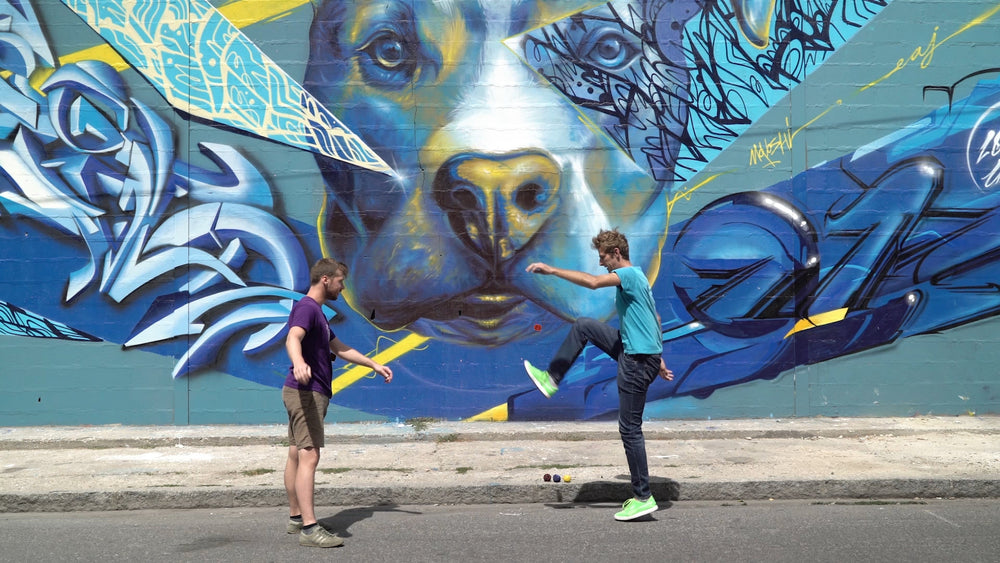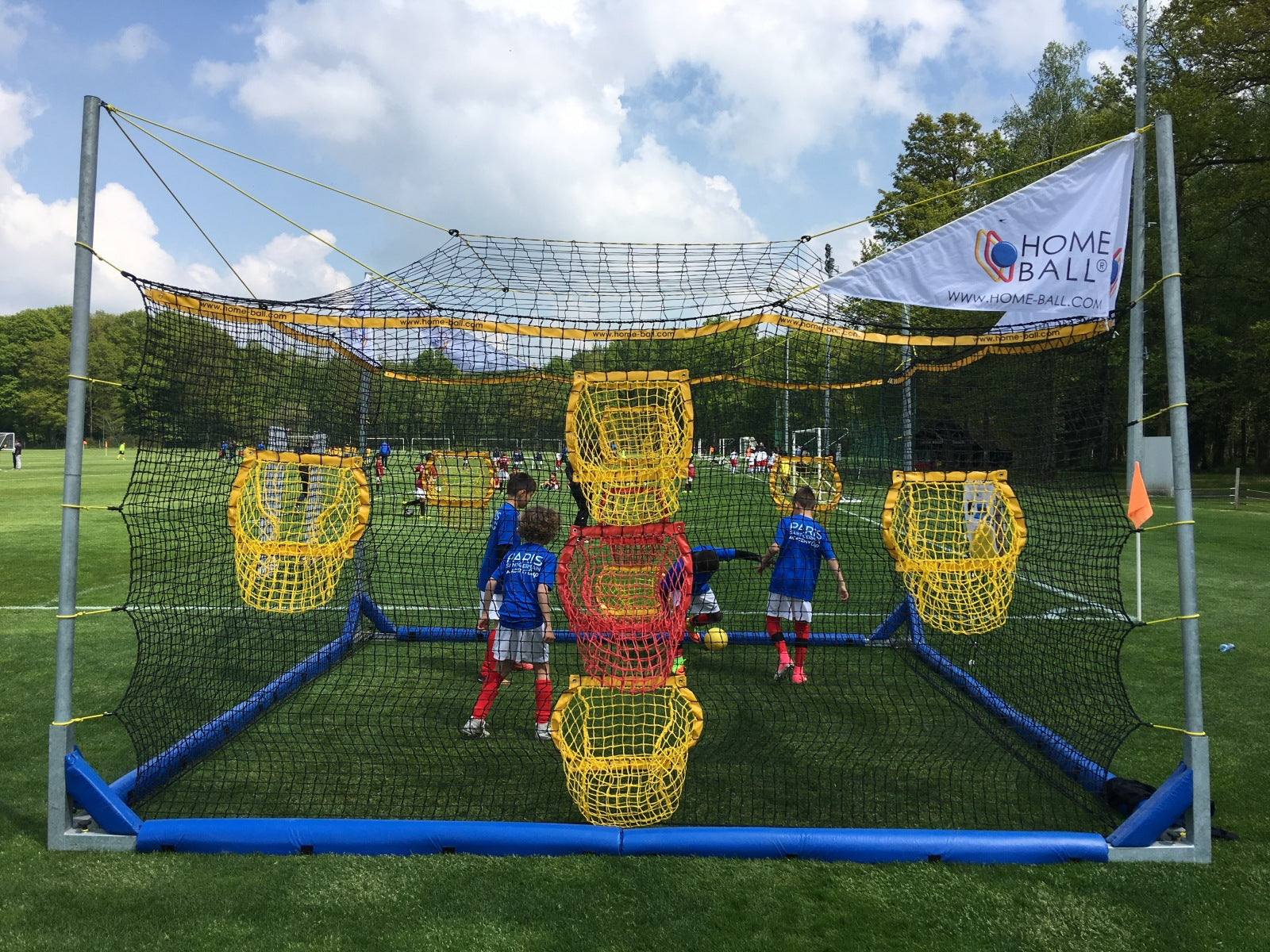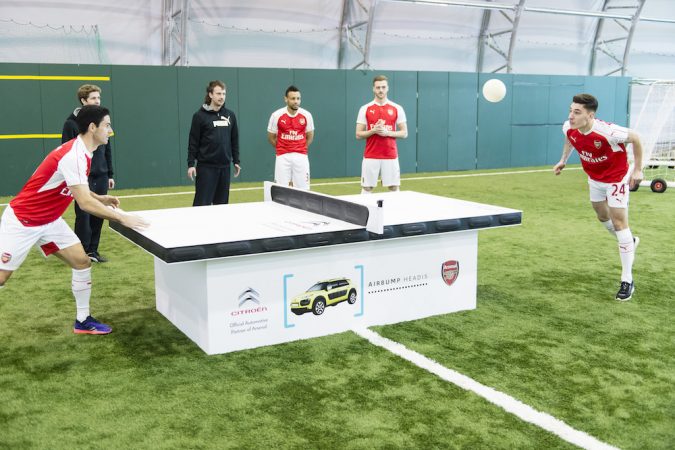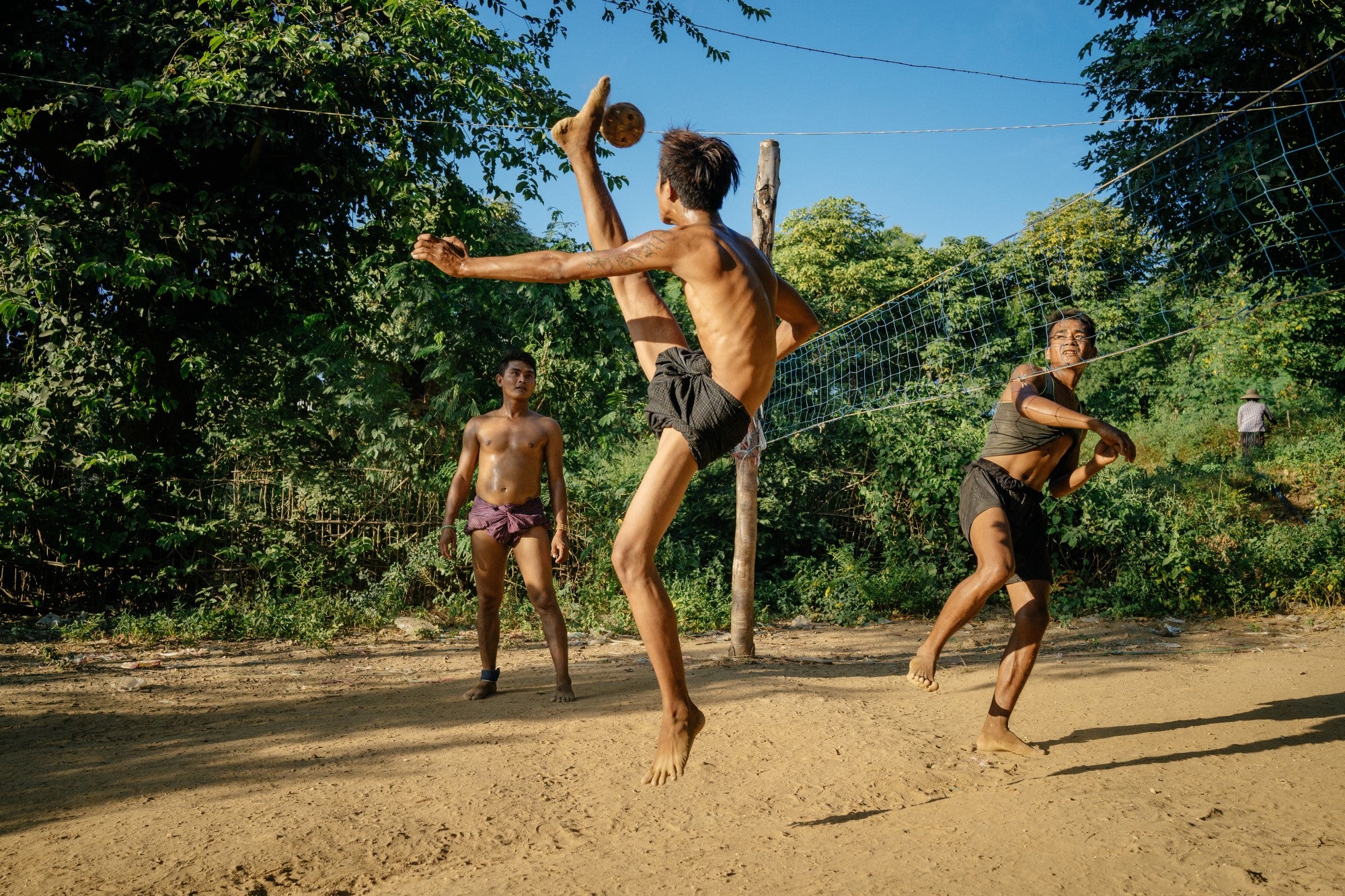Step-by-Step Guide: Building Your Own Football Pool Table at Home
Create your own foot pool court (also called billiards, football billiards or football billiards) and enjoy an original, friendly and ultra-fun game at any time!
Billiards – also called foot billiards , football billiards , or foot billiards – is a hybrid game combining football and billiards. Popularized in France by the Snookball brand in the mid-2010s, this giant billiards game is played with footballs instead of balls and with your feet instead of a cue. The rules of the game remain those of classic billiards, adapted to a human scale. Today, billiards is very popular in leisure centers, sports parks, and events, appealing to young and old alike. However, commercial billiards tables can be very expensive – often over €1,500 for a basic PVC model and up to €3,600 for plywood versions. Fortunately, there are affordable and Do It Yourself (DIY) solutions for creating your own billiards table, with portable structures that are easy to assemble/disassemble and can be used indoors and outdoors.
In this guide, we present all the low-cost and DIY solutions available for installing a football pool court at home or at events. We'll examine several methods (wooden structures, modular borders, inflatable structures, modular panels, etc.), detailing for each: the materials required, the approximate cost, the difficulty of assembly, indoor/outdoor adaptability, portability, and typical use cases.
What you need to get started
✅ A set of 16 Juggle Pro balls
✅ A flat surface (6.8m x 3.6m recommended)
✅ A little creativity to build your frame
Step 1: Prepare the play area
Before you begin, choose a flat surface , ideally:
- A terrace, a flat garden, a garage or a multipurpose room.
- Recommended dimensions: 6.8 m long x 3.6 m wide to comply with the official dimensions of the football pool table .
✅ Tip: If you have less space, adapt the ladder with size 2 balloons for children or a mini version indoors.
Step 2: DIY a pitch, or a football pool 'table'
Below, we outline the main solutions for building or installing a football table in an economical and flexible manner. Each solution meets different needs in terms of budget, DIY skills, and frequency of use.
1. Homemade wooden table (DIY)

A wooden football pool table is the classic DIY option for a sturdy structure at a low cost. With a little DIY, it's possible to build a large rectangular frame that mimics a giant pool table. This is an ideal solution if you want a sturdy and customizable table, for example, for a permanent installation in a garden or basement. Crafty DIYers can try their hand at building a homemade football pool table—it's often the smartest solution given the budget involved in buying a store-bought table.
- Materials needed: wooden planks (timbers, plywood, etc.), battens or rafters for the structure, screws/brackets for assembly, and possibly artificial turf or carpet to cover the playing surface. Buckets or baskets can act as pockets in the corners and in the middle of the long sides (like the holes of a billiard table). Rubber strips can also be added along the inside edges to improve the bounce of the balls.
- Approximate cost: Low to moderate, mainly the cost of building materials. If you're reclaiming pallet wood or scraps, the cost can be very low (a few dozen euros). With the purchase of new wood, grass mats, and accessories, expect to pay a few hundred euros at most, which is still well below the thousands of euros for a ready-made table. For example, a large sheet of plywood for the floor + planks for the sides + a set of artificial grass could cost around €200–400.
- Difficulty level: medium . Basic DIY skills (measuring, cutting, screwing) and tools (saw, drill/screwdriver) are required. The plan is quite simple (a large rectangle of the desired dimensions, with reinforcements). However, given the size (typically ~6 m x 3 m), you must be able to handle large pieces and ensure the overall strength. Allow several hours (or even days) of work.
- Indoor/outdoor use: a wooden table is suitable for both, but the wood will need to be treated if it is to be left outdoors (marine varnish, waterproof paint) to withstand the elements. Outdoors, the frame can be placed directly on a flat lawn. Indoors, you will need a sufficiently spacious room (a standard table measures approximately 3.60 m x 6.60 m , so make sure you have the space!).
- Portability: low if the structure is made of a single block, because the wood makes the whole thing heavy and bulky. However, a table can be designed to be dismantled in sections to facilitate transport: for example, 4 separate sides bolted together on site, and bottom boards in several parts. Even dismantled, it will remain bulky, but transportable in a utility vehicle. This solution is therefore more suited to a fixed or semi-fixed installation (e.g.: installed all summer in a garden, then stored away in winter).
- Typical use cases: permanent or long-term installation in a private home (play areas in the garden, converted garage, etc.), or in a leisure center wanting a durable site. Also suitable for small budgets who prefer to invest time in DIY rather than buying a ready-made table. It is perfect for family use or between friends. You can involve children in the construction for more fun. On the other hand, for ultra-mobile use (one-day activities), it is not the most practical due to transport.
2. Removable borders and improvised modular barriers

If you don't have the time or resources to build a full table, it's entirely possible to create a football pool court or 'table' by improvising borders on an existing surface (garden floor, terrace, gymnasium, etc.). The idea is to delimit a large rectangle on the ground with objects or modules serving as bands to contain the balls, a bit like the bands of a billiards table. This approach transforms any flat space into a temporary football pool table.
- Materials needed: Any linear element that can be used as a perimeter barrier . For example: long boards or timbers simply placed on the ground, thick PVC pipes , foam tubes (like pool noodles or gym bumpers) attached together, or even sports border modules if you have them (indoor soccer field barriers, rolled mats, etc.). The important thing is that the borders are ~15–30 cm high to hold the balls. For pockets , you can mark out areas at the four corners and mid-lengths (e.g., with hoops or buckets) where the ball must stop to be "pocketed".
- Approximate cost: very low , as you can use recycled materials or modular equipment used for other games. Wooden beams or rafters from a construction site can do the trick, or borrowed elements (benches, foam blocks, etc.). If you buy PVC pipes or wooden beams specifically, it remains inexpensive (a few euros per piece). Overall, this solution aims to minimize expenses by reusing existing resources.
- Difficulty level: very easy . There is no real construction, just setup. You have to be clever about stabilizing the borders (wedging them so they don't move under the impact of the balloons). For example, you can partially plant stakes in the ground against the boards to hold them in place (outdoors), or glue the edges to a hard floor indoors with gaffer tape. Assembly is quick (a few minutes to an hour at most).
- Indoor/outdoor use: suitable for both . Indoors (gymnasium, multipurpose room), the borders can be glued or weighted. Outdoors, they can be anchored to the ground if necessary. Be careful of the wind outdoors if you are using lightweight elements (foam, tarpaulins) - you will then need to secure them. This solution does not withstand rain well if the materials are cardboard or untreated wood (use plastic or treated wood for outdoors).
- Portability: Excellent . Improvised edging elements are often space-saving once disassembled: boards stacked, tubes stored, foam rolls, etc. In addition, they are multi-purpose (you can use them for other activities). Transport is easy in a utility vehicle or trailer, or even a car for smaller elements. Storage is also easy (the boards can stay outside along a wall, the foam can be stored in a corner, etc.).
- Typical use cases: one-off and event-based activities. For example, for a birthday afternoon in the garden, a leisure center that organizes a week of sports discoveries, a pop-up bar that wants to offer football pool during an evening, etc. It's ideal for testing the concept without a large investment.
3. Inflatable structure (inflatable football billiards)

Inflatable football pool is one of the most popular solutions for events and traveling uses. Here, the billiard cushions are replaced by an inflatable PVC structure which, once in the air, forms a large rectangular frame with thick edges and "holes" at the corners. It is in fact very similar to a bouncy castle with walls forming a billiard table. This concept, sometimes called inflatable human billiards or giant inflatable football pool , offers an excellent compromise between cost, safety and ease of assembly.
- Materials needed: The structure itself is usually made of thick PVC (tent or bouncy castle canvas), supplied by the manufacturer. It includes the tubes forming the strips and sometimes a canvas bottom (otherwise it is placed on a surface such as grass). You must add an electric blower (like a bouncy castle fan) to continuously inflate the structure, plus stakes and anchor ropes if used outdoors (to prevent the frame from moving or flying away). The kit generally includes the set of numbered balloons.
- Approximate cost: Moderate . Compared to rigid tables, this is the cheapest new option on the market: around €800 to €1200 to buy a new inflatable football table from a manufacturer (depending on the size and design). You can even find models around $700-800 (approx. €600-750) on wholesale sites alibaba.com .
- It is also possible to rent these inflatable structures for around €150 to €300 per day, depending on the provider. For example, some entertainment companies offer rental of a ~6x4 m inflatable football pool table for just €130 per day. allanimation.fr , while others charge ~ €260 per day for a similar 6 x 4 m model – and up to €300 seen for premium installations. Buying second-hand is rare (these structures are still relatively new), but some parks occasionally resell them.
- Difficulty level: very easy . Assembly is as simple as unfolding the inflatable tarpaulin on the ground, plugging in the blower, and letting it inflate (it only takes a few minutes). Then, you need to secure it: attach the corner strings to the stakes if you're outdoors, or place weights on the corners indoors. The complete installation takes two people less than half an hour. No technical skills are required, just provide a 220V power supply on site.
- Indoor/outdoor use: quite versatile . These inflatable structures can be used outdoors on grass, earth or synthetic surfaces – the PVC material is robust and resistant to friction. Indoors (large gymnasium, exhibition hall), it is also possible, provided you have sufficient space (approximately 6 to 7 m long and 4 to 5 m wide for standard models). However, be careful of bad weather : in case of strong winds, it must be properly secured, and in rainy weather it is better to dismantle (the blower must not take on water, and the game becomes slippery). These inflatable games often comply with safety standards (EN14960) for public use
- Portability: Excellent . Once deflated and folded, the inflatable football pool table fits into a large bag and can fit in the trunk of a car or a small van. Its weight can be around 40–80 kg depending on the size – it usually takes two people to carry it, but it is still easier than a large wooden structure. The blower is an accessory about the size of a small industrial vacuum cleaner. Simplified storage: the whole thing takes up the space of a folded tent. It is therefore ideal for event professionals who move from site to site.
- Typical use cases: mobile and professional entertainment . This format is popular with event companies, team-building companies, communities and rental companies of play structures. It is suitable for parties, fairs, trade fairs, seminars , etc., because it attracts the public and sets up quickly. Its colorful look and inflatable edges reassure parents for children (no risk of bumping into hard ground). Many leisure centers also choose inflatables for their cost-effectiveness : it is the most economical way to have an operational football pool table, while being able to store it when not in use. Finally, for a very motivated individual who often organizes events at home, buying an inflatable can be interesting - you can even follow the advice of some and make it profitable by renting it to others when not in use.
4. Removable modular panel system

Modular panel systems represent another approach, often used in high-end commercial models or by experienced DIY enthusiasts. This involves building the foosball table frame with several rigid panels that fit together much like the pieces of a puzzle or a flight case. Once fitted together and secured, they form a solid structure, but they can be disassembled for transport. This category includes, for example, tables made of cut multi-ply plywood, with mounting hardware, or rigid plastic kits. The advantage is that they combine quality of play (firm bounces, "real table" look) with modularity.
- Materials needed: If you're building it yourself: thick plywood or MDF boards, cut to fit the frame design (side strips, corners with holes, etc.), and a support structure if needed. Consider sturdy fastening systems to secure the boards: flight case locks, powerful recessed magnets , latches, etc. (Snookball, for example, uses magnetic and "fly case" type fasteners in its metalobil.fr tables). You'll also need material for the playing surface (panel flooring or grass mats) and pockets (often a net or basket under each hole). If you're buying a ready-made modular kit, everything is included in the boards.
- Approximate cost: Moderate to high . DIY costs depend on the material chosen and the complexity: good quality marine plywood, cut to size, plus special hardware, can easily cost €500 and more. However, you can optimize by using standard wood and DIYing the fasteners, for perhaps ~€300 in materials. Buying modular tables is not cheap: PVC or plastic kit models are around €1500 each, and custom-machined plywood versions can cost €2500–3500 (often manufactured in small batches in Europe). This is a significant investment, generally reserved for intensive commercial or professional use.
- Difficulty Level: In DIY , this option is complex . Designing sturdy panels that fit perfectly requires advanced woodworking or digital fabrication skills (CNC cutting, etc.). Assembling the panel set itself is not complicated once they are made (a few minutes to clip/screw), but the initial fabrication is arduous. If you buy an existing modular system, then assembly is easy (the modules are designed to fit together intuitively, often without tools). So the level ranges from expert (DIY) to beginner (commercial kit).
- Indoor/outdoor use: depends on the materials. Wooden panels must be treated for outdoor use (otherwise they risk swelling or deterioration). Commercial versions often have an anti-humidity treatment and can be used temporarily outdoors, but not in continuous rain. There are modular designs in metal or plastic that would be ideal outdoors (there is even talk of aluminum or stainless steel versions for permanent outdoor use). Indoors, no problem, this is even where a beautiful modular football pool table will come into its own (neat aesthetics for a trampoline park hall, a youth center, etc.).
- Portability: good . Compared to a single-piece table, portability is greatly improved: you can dismantle and transport the whole thing in several stackable panels. Each panel remains quite large (several meters long for the side panels) and heavy if it is made of wood, so you need a suitable vehicle for transport (van). But overall, it is designed to be semi-mobile . Count several large pieces + a few corner pieces. An example: a complete Snookball table can fit on a pallet for delivery in kit form, which gives an idea of the folded volume. Assembly/removal will take a little longer than an inflatable (maybe 30 minutes for 2 people), but remains possible for events.
- Typical use cases: This solution is preferred for professional installations wanting a premium look: games rooms, bars with atmosphere, indoor sports complexes that integrate a football pool table as an additional attraction. It is also used by certain high-end event providers who want an alternative to inflatables (for example for chic corporate events where aesthetics count, or indoors when you want to avoid the noise of the blower). Finally, a DIY enthusiast could embark on a modular DIY model for the technical challenge and the satisfaction of having a unique demountable table.
Comparative table of solutions
To recap, here is a summary comparison of the different football billiards solutions discussed, according to several practical criteria:
|
Type of solution |
Materials / Design |
Estimated cost |
Difficulty of assembly |
Interior / Exterior |
Portability |
Typical uses |
|
DIY wooden table |
Wooden structure (planks, plywood), possibility of synthetic grass, bucket/ net pockets . |
Low to moderate (€100–400 depending on material recovery). |
Medium – requires DIY, tools and time. |
✔ Interior ✔ Exterior (treated wood) |
Low (very bulky, heavy unless disassembled). |
Permanent or semi-permanent installations (homes, schools). Limited budget, motivated DIY enthusiasts. |
|
Improvised modular borders |
Various edging elements (boards, foam, tubes) placed on the ground to mark out the area. |
Very low (often €0–100, using existing hardware). |
Very easy – simple setup, low tech. |
✔ Interior ✔ Exterior (if properly secured, out of the rain) |
Excellent (separate parts easy to transport). |
One-off events, temporary solutions, quick demonstrations. |
|
Inflatable structure |
Inflatable PVC frame + blower, integrated pockets, optional floor mat. |
Moderate (€800–1200 new; rental ~€150–300/day). |
Very easy – inflates in minutes, little physical effort required. |
✔ Indoor (large space required) ✔ Outdoor (avoid strong wind, rain) |
Excellent (foldable, transport in bag, < 1 m³). |
Mobile entertainment, leisure parks, team building, children and adults. |
|
Modular panels |
Rigid panels (wood, plastic) with fasteners (magnets, latches) forming a removable frame. |
Moderate to high (DIY €300–600; retail €1500+). |
DIY: Difficult – advanced technical design. Kit: Easy – guided assembly. |
✔ Interior ✔ Exterior (if treated material and temporary use) |
Good (stackable panels, requires utility for transport). |
Professional facilities, bars, high-end events, regular use with storage requirements. |
( ✔ Indoor/Outdoor: can be used in this context subject to the precautions mentioned)
Embark on the DIY football pool adventure
Building your own football pool court is easier, more economical, and more fun than ever. Whether in a backyard, gym, or on a sports field, you now have everything you need to create your own setup and enjoy this unique game with family, friends, or at events.
With our Juggle Pro balloons , you can choose the size best suited to your space and your audience:
- Size 2 – Ideal for children and compact terrain
- Size 3 – Official size, perfect for a realistic and user-friendly experience
Discover our balloon sets and start your DIY field today!



















